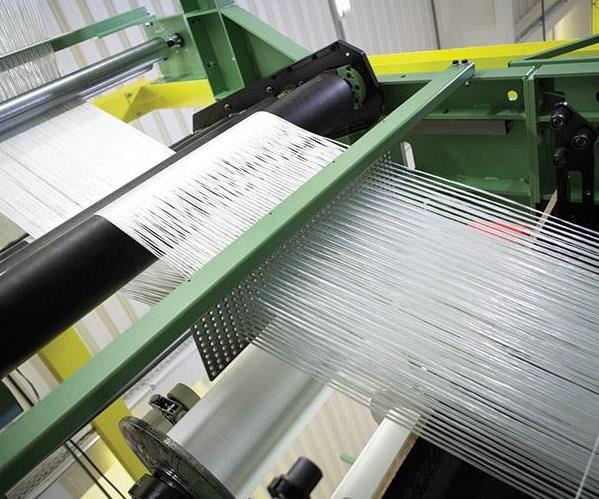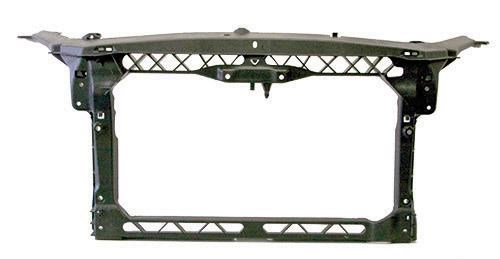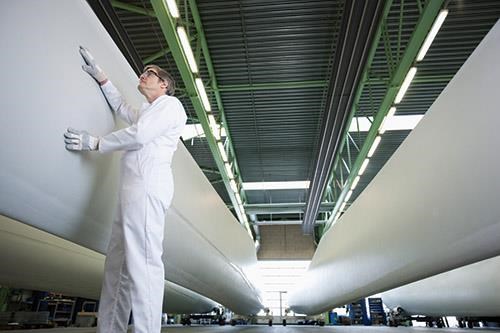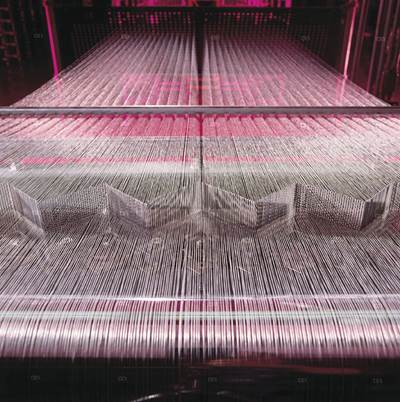Fine-tuning fiberglass: Smart fiber sizing
Some insights into those proprietary chemistries that can customize performance at the fiber/resin interface.
In the composites industry, fiber is a significant topic of conversation. Fiber sizing rarely gets a mention. It is difficult, however, to overstate sizing’s importance. Without it, the fiber could quickly begin to fray during handling and processing (see Fig. 1, at left), and would resist bonding with the matrix resin. In addition, sizing is credited with improving mechanical properties, such as tensile strength and resistance to impact, fatigue and chemicals, and promoting thermal stability and hydrolytic stability and more.
The biggest sizing consumers are glass fiber manufacturers. Worldwide annual production of fiberglass composite materials is nearly 9.07 million MT, and fiberglass accounts for some 95% of all fiber reinforcements processed by the composites industry, according to Prof. James L. Thomason, University of Strathclyde (Glasgow, Scotland, UK).
One of the largest glass fiber manufacturers in the world is PPG Industries Inc. (Shelby, NC, US). It uses silica (SiO2) sand and other selected raw materials co-melted in a 1450°C furnace and directed through forming bushings that shape glass fibers (learn more by clicking on "The making of glass fiber" under "Editor's Picks" on the top right). The fiber sizing is applied immediately after the filament exits the bushing. “We’re applying our coating that’s about 100 nm thick to a cylindrical surface that’s around 10-20μ in diameter, and is moving at speeds approaching 100 mph [160 kph],” explains James C. Watson, associate director, fiberglass science and technology, for PPG Industries, “and we’re doing it 24 hours a day, 7 days a week, 365 days a year. We never stop.”
“It’s a little bit of a challenge,” he quips, pointing out that after it is applied, the sizing also must remain on the fiber and perform its functions throughout all subsequent phases of the glass manufacturing process, the customer’s part manufacturing process and the finished part’s lifecycle. He adds that in terms of the total composite, sizing can make up as little as 0.2-0.3% of the final product, yet it has an “amazing impact on productivity and part performance.”
What is sizing?
Sizing describes, respectively, the coating itself and the coating process. Whittington’s Dictionary of Plastics (Third ed., CRC Press, 1993) defines the latter as “applying a material to a surface to fill pores to smooth it and reduce absorption of a subsequently applied adhesive or coating; or to otherwise modify the surface.”
Today, sizing chemists (see Fig. 2, at left) primarily aim first to protect the fiber by reducing friction during processing and to prevent fiber breakage during part manufacturing. Second, they provide a compatible interface between the fiber and the matrix resin in the composite part. Specifically, sizing enables transfer of stress across the fiber/resin interface.
“The sizing controls the interface between the glass and the resin and, therefore, optimization of the sizing chemistry gives you the best interfacial performance between the glass and the resin. Good interfacial performance leads to improved mechanical performance and to better processability as well,” explains Christopher Skinner, director of products for the strategic marketing group at glass fiber manufacturer Owens Corning (OC, Toledo, OH, US).
Glass fiber sizing primarily comprises a film former, typically chemically similar to the intended matrix resin, and a coupling agent, almost always an organic silane base in a complex mixture of chemistries that gives the inorganic glass fiber the ability to bond well with the organic resin matrix. The silane coupling agent acts as a primer that enables the film former to attach to the fiber and also adhere to the polymer matrix.
Watson points out that silanes are the glass fiber sizings chemists’ workhorses. “But as we move forward to higher temperature, higher durability, longer life term, better fatigue performance and other improved performance, we must ask ourselves if there are better organic silane molecules that can be used to bring those properties to bear — even though they are invariably more expensive.”
Differentiation + optimization
Today, there are no general-purpose sizings — no one-size-fits-all formulae, says Steve Bassetti, global marketing manager, fibers and composites, for fiber sizing supplier Michelman (Cincinnati, Ohio, US). “Several key variables need to be understood in the sizing selection process,” he says, expanding on his theme: “Clearly, [one is] the resin that the fiber is going to be put into, be it polyester, epoxy, polypropylene, nylon, PAEK or other.”
Fausto Pellegrini, key account manager and team leader for Aliancys AG (formerly DSM Composites, Schaffhausen, Switzerland) says, for example, that Aliancys is working on sizings for excellent wettability and compatibility with newer styrene-free resins. “Often,” he explains, “sizing chemistries for styrene-containing thermosets do not perform well when used with new styrene-free resin that is based on methacrylate solvents and derivatives.”
Second, says Bassetti, is the intended process, which includes whether the sizing is for chopped or continuous fiber and the forming method, such as compression molded sheet molding compound (SMC) or filament winding.
PPG’s Watson says, “An important trend in the past 5 or 10 years has been a great broadening in different kinds of glass compositions, in addition to traditional E-glass, to more corrosion-resistant ECR glass and to high-modulus glasses.” Sizing products, therefore, also are increasingly driven by changes in glass composition and accompanying changes in the fiber surface to make sizing compatible with corrosion-resistant, low-boron or boron-free glass, for example, or high-modulus glasses for wind turbine blades, he says.
Aliancys, says Pellegrini, is developing sizings for specific inline wetting processes, such as pultrusion and filament winding, aimed at reducing part production time and process energy consumption. Last but not least, the chemist must consider part performance and the environment where the part will be installed — an automotive interior, underhood or fuel-system component, an electronic laptop component, a wind blade or one of myriad other market applications. That includes the challenge to sizing chemists of part size. Aliancys’ Pellegrini says that sizings based on low-molecular-weight epoxy chemistry have been successfully used for years in wind turbine blades and other direct roving applications. Wind blades are getting longer, however, to increase wind turbine power output, emphasizing the need for durability, stiffness and fatigue resistance in fiberglass blades.
Skinner notes that blade manufacturers invest an “incredible amount of money in tooling” for, say, a 75m long blade. And then “they put more than 40 tons of glass into a mold and infuse it with resin.” With so much capital in fixed assets, the ability to make parts quickly is critical. “So the ability of sizing chemistry to respond to the increasing scale of applications is a key factor in sizing innovations,” says Skinner. Here the fiber/resin bond is key. “So we’re driving interfacial science to drive up the performance of our products.”
The industry is asking for fiber performance improvements that will demand specific sizings, tailored, customized and optimized in a way appropriate to the end-use application, Bassetti explains, noting that for Michelman’s line of sizing products, including its registered flagship product, Hydrosize, the fiber interface is becoming more critical as advances in resin and fiber technology reach maturity. “Today’s research is targeted at specific applications,” Bassetti points out, offering as examples, a polypropylene supplier that might be looking for low VOCs in automotive interiors (see Fig. 3), or a nylon supplier that might need greater hydrolytic resistance or better glycol resistance.
Bassetti sums up the trend in a single word: Specialization.
Competition + regulation
Pellegrini frames the specialization trend in terms of global market pressures. Demand for glass fiber will continue to be high, but strong price competition from fiber suppliers in Asia has been a factor in challenging established glass fiber producers to focus on reducing costs by improving their efficiency and productivity.
“Composites is typically seeing 4-5% annual growth,” agrees OC’s Skinner, based on well-documented substitution of composites for legacy wood and metal for the purpose of weight reduction and/ or corrosion prevention, but he also notes what he calls specialty features — specific durability or aesthetic, acoustic or weather- resistance requirements prized for building construction materials.
Skinner adds that the European Union’s REACH legislation, adopted to enhance human and environmental protection from risks posed by certain chemicals, also is driving sizing developments. It’s not just about low VOCs in sizing, but also about the highly specialized chemicals that are used in sizing to produce specific effects. “The REACH legislation has a hand in specifying approved chemicals,” Skinner points out. So a big challenge for sizing chemists is to achieve the desired effect yet comply with the legislative environment. In other words, “How do we continue to innovate and respond to corporate social responsibility?”
Pellegrini notes that among Aliancys’ R&D efforts in VOC-free sizing formulations for reduced environmental impact, are sizing chemistries that meet new European regulations for parts in contact with food.
“We are seeing more and more demand coming from the automotive industry,” notes Gilles LeMoigne, Michelman’s global industry manager, fibers and composites, as automakers turn to also is on the table for its chemists. “Michelman aims for sizing designs that will help the auto industry meet the latest regulations for composites manufacture.” These include such goals as low or no volatile organic compounds (VOCs) in its sizing, and sizing that will meet specific targets for impact resistance or tensile strength.
Sizing for glass/thermoplastics
On the cutting edge of the custom-designed sizings trend are thermoplastic composites. Bassetti insists that any composite, and a thermoplastic in particular, is under-optimized when a general purpose sizing is selected. “Again, our business is to specialize the interface and improve the composite performance,” he says.
But he cautions that the latest in thermoplastic sizing is still being developed and validated, and good products are not necessarily commercially available yet. In this arena, as well as in thermosets, he reminds us Michelman is working toward specific sizing targeted at different applications: Long-fiber thermoplastics (LFT) using polyamides (nylon) and polyolefins — polypropylene (PP) primarily — aimed, for example, at automotive seat backs, load floors, door modules and other interior parts.
Skinner sees a general trend in resin selection from poly ester and vinyl ester towards polyurethane (PUR) — a family of polymers with widely ranging properties that may be thermoset ting or thermoplastic. “I expect the ability to effectively interact with the PUR matrix is going to become more important in the future,” Skinner says.
A real sizings “hot spot” — figuratively and literally — is automotive underhood applications, where high temperatures and corrosive liquids, such as ethylene glycol (in anti-freeze), and other hot fluids “bring stringent requirements to the design of fiberglass,” says PPG’s Watson. “The sizing design can result in orders of magnitude improvement in performance, particularly for high temperature and hydrolysis.” The best resins for this extreme environment are typically thermoplastic. The workhorses here are nylon (polyamide), PP and thermoplastic varieties of polyester, with limited volume in the poly- etheretherketone (PEEK), polyphenylene sulfide (PPS) and polyaryletherketone (PAEK) resins.
Emerging technologies also will demand customized and improved sizings for best interface functions, Bassetti adds. For example, new ways to use continuous fiber or higher aspect ratios to build additional strength into the composite — processes that require thermoplastic prepregs or organo sheets (strong, light-weight continuous fiber-reinforced thermoplastic structural components) and thermoplastic resin transfer molding (RTM) — are creating new opportunities to optimize the sizing and fiber/ matrix interface, Bassetti says. Michelman is actively working on sizing upgrades to fulfill the requirements of these advancements (see, for example, Fig. 4).
The latest in sizing technology
Silanes and other sizing components, such as dispersants and emulsifiers, are provided by several divisions at chemical manufacturer Evonik (Essen, Germany). Evonik dedicates a portion of its research to new sizing systems and ingredients. The components that most distinguish one fiber manufacturer’s product from comparable fibers produced by another, sizings are highly proprietary (see Learn More located under "Editor's Picks" on the top right). “Fiber sizing is one of the big secrets of fiber manufacturers,” says Stephan Sprenger, the senior market development manager for composites and lightweight construction with Evonik’s Business Line Interface & Performance group. So it was a notable exception when Sprenger revealed to CW that his team is working on the improvements possible when nanosilica (SiO2) particles are added to sizing in quantities of <1 wt/%.
“When cyclic forces are applied to a fiber-reinforced composite or a sudden impact occurs, microcracks can form within the resin matrix, and over time, the crack propagates through the matrix and along the fiber,” Sprenger says. Testing concluded that toughness and fatigue performance of a glass or carbon fiber composite could be significantly improved by adding “small levels of an aqueous emulsion of an epoxy resin containing nanosilica to the sizing,” Sprenger says.
A 30-40% increase in fatigue performance was achieved in tests with continuous glass fibers and continuous carbon fibers in unidirectional fiber-reinforced epoxy. Sprenger points out that this would be a significant increase in performance of rotor blades for wind energy conversion, for example (see Fig. 5, below). For more on carbon fiber sizing, see the Side Story at the end of this article or click on its title, "Sizing for carbon fibers," under Editor's Picks.
Called Nanopox, the aqueous emulsion as a sizing ingredient has been tested with epoxy resin matrices, and Sprenger and his team are researching its use with unsaturated polyester and vinyl ester resin matrices. Sprenger considers Nanopox a real break-through for sizing manufacturers, at a small additional cost. Further, it is considered viable with any thermoset but, Sprenger says, perhaps not thermoplastic resins.
The same nanosilica particles also can be used to modify the matrix resin, which could achieve even bigger improvements in parts such as automotive composite leaf springs. But he adds the caveat that “modifying the matrix comes with a price, and it might correspondingly affect speed of the manufacturing process.” Sprenger emphasizes that adding it to the fiber sizing is a very cost-efficient way to improve composite performance in cost-critical applications such as wind turbine rotor blades or mass-produced automotive parts.
Right sizing for success
For many years, as composites fought for a foothold in automotive, aircraft, construction, piping and other markets that were quite comfortable at the time with concrete, wood or metal, sizing played a key if often unheralded role in the successful substitution of fiber-reinforced polymers for legacy materials. But even in the most successful cases, designers, manufacturers and end-users want far more than a substitute. They want fiber-reinforced polymers with ever greater strength, toughness and endurance than legacy materials. And they want faster productivity. All at a lower cost.
Can fiber manufacturers, sizing chemists and formulators really achieve the upgrades in performance and productivity that their customers demand? They are well aware of the need, and they are certainly suiting up for the challenge. Sizing and fiber manufacturers are coordinating with their customers to hear what they want. And they are taking that information back to their scientists, who are focusing their chemistry on fine-tuning sizing formulations to make specialization a reality, developing the specifically tailored, customized and optimized sizings to satisfy industry demands.
Related Content
Sunreef Yachts completes 43-meter single-shot hull infusion project
Sunreef 43M Eco electric catamaran, with a composite surface of 1,700 square meters, is considered to have the world’s largest infused hull.
Read MoreNovel insert technology enables arc stud welding with composites
FAUSST technology enables fast, reliably welded connection of metal components in composite structures.
Read MoreToray obtains ABS type approval for in-situ VARTM ship repairs
American Bureau of Shipping (ABS) certifies use of jointly developed CFRP repair technique on FPSO and FSO industrial systems, addressing traditional steel restoration challenges.
Read MoreRevisiting the double vacuum debulk process
Evolution of the double vacuum debulk (DVD) process over the years continues to advance its “near autoclave quality” for low-void, highly compacted repair patches.
Read MoreRead Next
The making of glass fiber
The old art behind this industry’s first fiber reinforcement is explained,with insights into new fiber science and future developments.
Read More“Structured air” TPS safeguards composite structures
Powered by an 85% air/15% pure polyimide aerogel, Blueshift’s novel material system protects structures during transient thermal events from -200°C to beyond 2400°C for rockets, battery boxes and more.
Read More
























